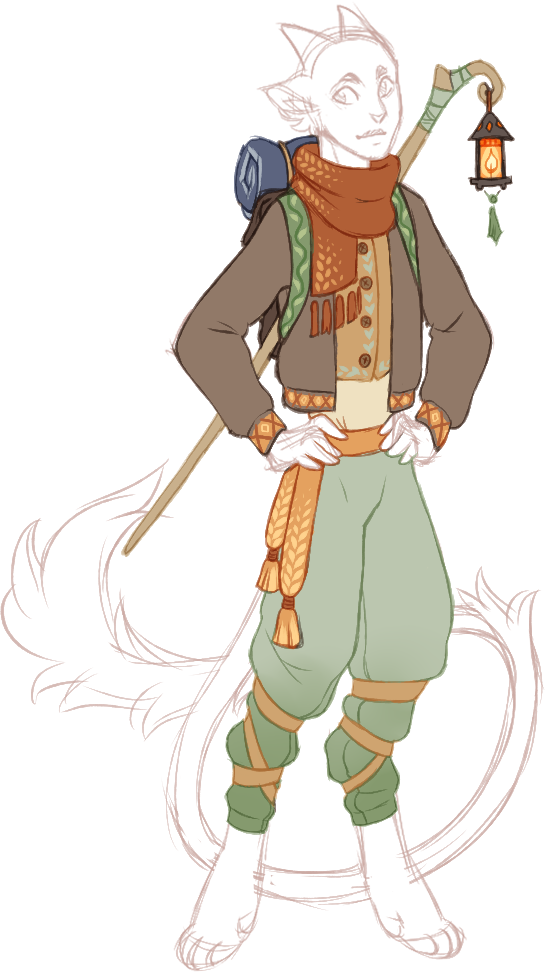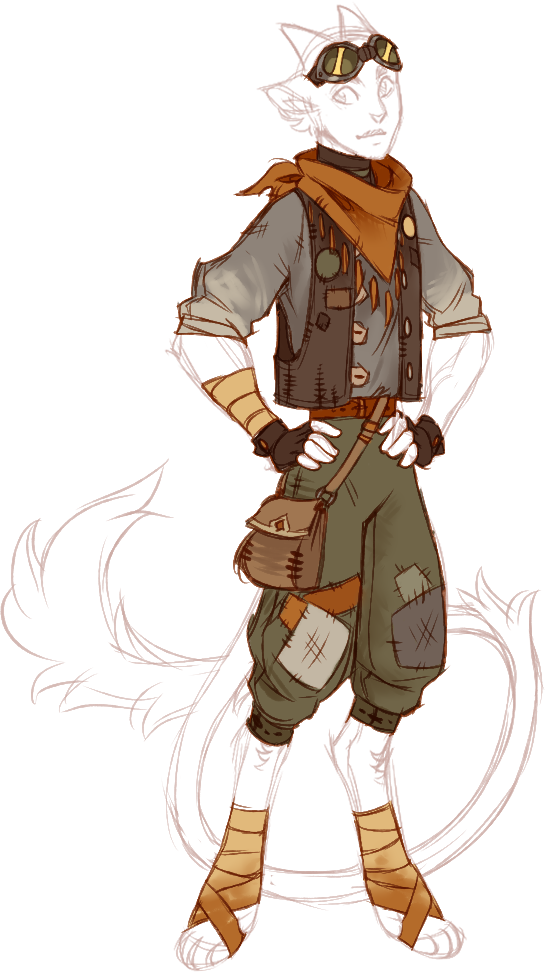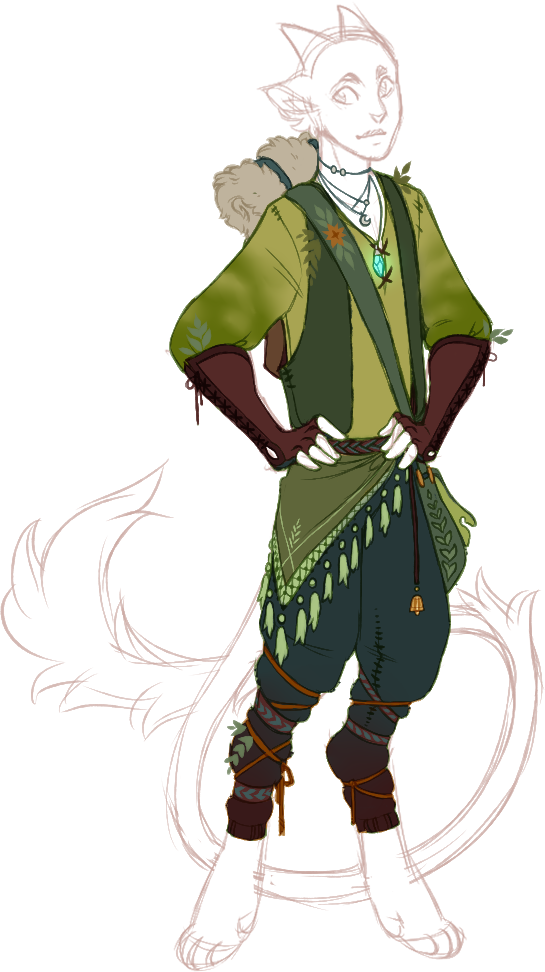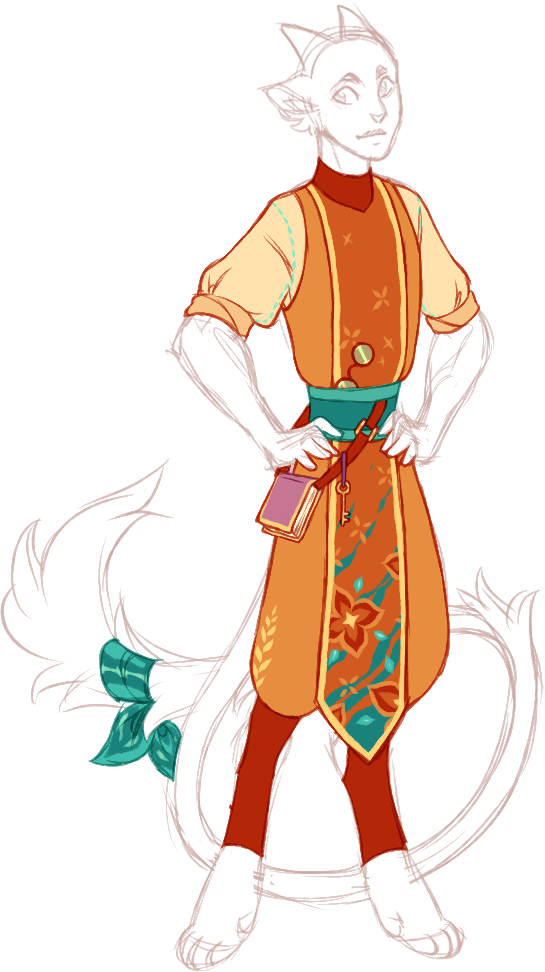Table of Contents
Life Cycle
Conception
A baby kebanzu can be born of 2 parent kebanzus of mature age. The sex of the parents does not so much matter because of their shapeshifting abilities, all couples of any configuration are able to procreate. Gestation takes about 6 months and then 1-2 babies are born.
Baby
A kebanzu kitten is born mostly developed but is still dependent on the parent and cannot travel on their own. Though they start out small and sleepy they soon grow into entertaining balls of energy. As babies kebanzus are unable to shape shift and must learn to master the skill of changing their shape. Baby Kebanzus have simplified markings, that somewhat preview their adult markings with flat blocks of color. These color blocks will develop intricacies such as fades, freckles, and stripes as they age. Baby kebanzus lack horns, and will continue to lack horns until they reach the age of 10.
Adolescent
Around the age of 10-20 a kebanzu will start to mature. Horns will begin to grow, finer detail markings will begin to come in, and they will start to master the art of shapeshifting. This is usually the age where they start to collect "shinies", small usually shiny or reflective objects that are treated like pieces of treasure whether they are actually worth anything or not.
YoungAdult
Around the age of 20-50 a kebanzu is considered a young adult. By this age they have usually gotten a hold of shapeshifting and are visually developed for the most part (horns and fur pattern have grown in and will mostly stay the same for the rest of their life).
Adult
The ages of 50-100 are considered adult kebanzu years. They will usually travel great distances, inhabit multiple cities and shelters, make partnerships, and have children of their own.
Elder
The ages of 100-200 are considered the elder years. This is when a kebanzu will usually settle down where they will spend the rest of its days and cease traveling. The place they choose may or may not be a kebanzu city, but might be a shelter of some sort (usually an abandoned house or building, far away from people). Though it is not common, some of the more powerful druids have lived to be up to 250 years old.
Hibernation
Every Kebanzu possesses the ability to hibernate for decades and sometimes centuries in their plant form. These years spent in hibernation are not counted towards a kebanzu's age.
Partnerships
Romantic
Kebanzus often make romantic partnerships with other kebanzus. These partners will often travel together and share with one another, sharing in their company and caring for each other closely. These relationships are very close and respected by other kebanzus. These are easily comparable to human romantic relationships, but are somewhat in between dating and married status. Kebanzus do not have the concept of marriage in their society, and the idea of dating is somewhat in the same category as friendship.
Sexual
Sexual kebanzu partnerships usually go hand in hand with romantic ones, but not always. Sometimes sexual partnerships are just flings or used to have offspring, and romantic partnerships can exist without sexual partnerships.
Platonic
Kebanzus sometimes form platonic partnerships with each other. These partnerships are stronger than friendships but a bit less than romantic partnerships. Platonic partner kebanzus will generally spend a lot of time together, caring and looking after each other, and traveling together. The care and love they might have for each other is not romantic though. For example siblings, that travel together and care a lot about each other, would be a platonic partnership.
Friendship
Kebanzus make countless friends and acquaintances. They are very social with other kebanzus and sometimes even social with humans (when in human form). They often use these contacts to their advantage, both socially and when in need of help.
Society
Cities
Kebanzu cities are a tricky bit of magic. They are fairly common and are located anywhere from the mountains, to rural countryside, to forests, to deserts, to bustling human cities. Kebanzu cities cannot be found without the help or presence of an actual kebanzu. Kebanzu cities are on a slightly different dimension than ours, that can be accessed by kebanzus walking on the inter dimensional entryways to said cities. These cities basically overlap large expanses of land, and with the help of inter dimensional planes, cannot be found by humans even if they are standing in the geographical middle of them. The best way to access a kebanzu city if you don't have the help of a kebanzu is to follow one. If a person follows a kebanzu all the way to the city without taking their eyes off of the kebanzu then they will arrive in the actual city and on the inter dimensional plane, but if said follower takes their eyes off the kebanzu for even a second, the kebanzu will vanish and the follower will "fall" back to earth's plane of existence. Kebanzu cities are generally round in overall shape, with many unusually shaped buildings that reach 3 levels high. The buildings are separated by "paths" and "roads" that wind through them and also border the entire city itself. The buildings are often connected by many rope bridges that cross over the paths and roads.
The city is surrounded by a tall smooth wall with 2-3 main entry points and countless secret passage escape routs. At the center of the city is a large round open area with a well at its center.
Shelters
Kebanzu shelters are usually abandoned houses and buildings that have been taken over by wandering kebanzus and converted into living spaces. The outward structure is usually covered in various plants to hide it better and the inside is filled up with all sorts of treasures and items that the resident kebanzu has collected. It is common for older kebanzus to take up shelters where they spend the rest of their lives.
Travel
Kebanzus are highly nomadic in their nature. They are almost constantly on the move. Kebanzus prefer areas that have less human civilization to travel through, but won't exactly avoid an area if humans are there. Some kebanzus prefer to travel alone but most like to travel in small groups or pairs.
Social Structure
Kebanzus are highly social beings. Even lone nomadic kebanzus will quickly flock together if they share a common path with other kebanzus traveling in the same direction. They love to commune and share stories and trade various treasures they have snuck away from unsuspecting humans.
Kebanzus have a set hierarchy that is for the most part respected. Apointed leaders of kebanzu cities work on making sure it is running more than anything else. Out side of cities some traveling groups of kebanzus will elect a leader of the group.
Gender Roles
Kebanzus do not have the concept of gender roles. They do have gender presentation, feminine, neutral, masculine and other presentations, but they do not enforce certain sexes to conform to certain genders.
Relation With Humans
Kebanzus generally avoid humans at all costs, but will use them to their advantage if they need to. Kebanzus have the ability to shape shift into a human form unique to only themselves. In this human form they can interact with humans, trading items for food, hitchhiking a ride, etc... without setting off too many red flags. Some are better than others at interacting with humans, usually from practice and a lot of traveling. Some kebanzus prefer human life to living in constant travel, and will use their abilities to stay in human form for as long as they can. Although the few that do this are generally successful at blending in and socializing, staying in a human form is very tiring and draining on their bodies. These kebanzus tend to be very tired and need to rest in their true forms whenever they can.
Kebanzus can befriend humans and trust them enough to reveal their true identity, tho this is very uncommon. It is also within the realm of possibility for a kebanzu and a human to fall in love, with the kebanzu then granting them a shifters emblem so they might be able to join them in kebanzu society.








